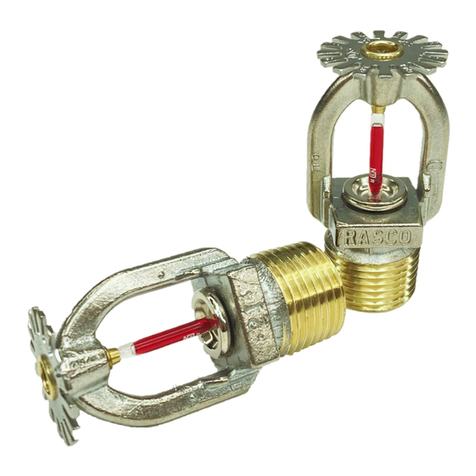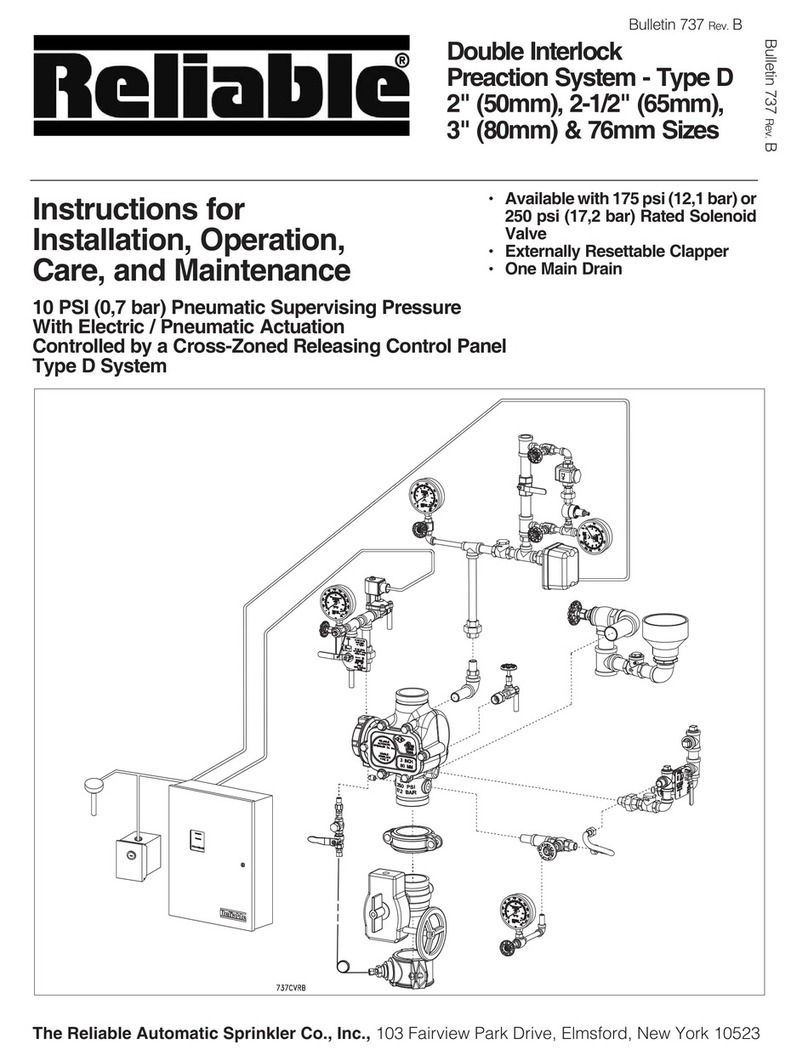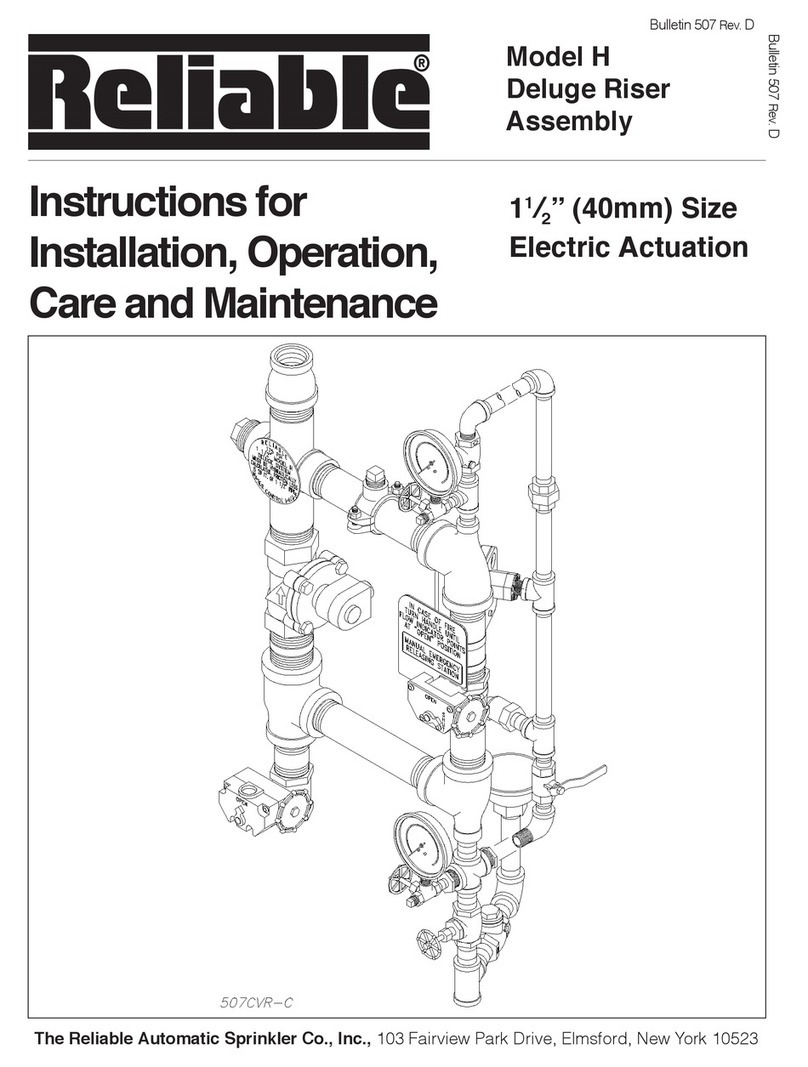Reliable B1 Maintenance manual

The Reliable Automatic Sprinkler Co., Inc., 103 Fairview Park Drive, Elmsford, New York 10523
Bulletin 323 Rev. E
Bulletin 323 Rev. E
Instructions for
Installation, Operation,
Care and Maintenance
Model B1
Accelerator
with Integral
Accelo-Check
Features
1. Quickens the operation of dry pipe valves.
2. Increases the number of automatic sprin-
klers controlled by one dry pipe valve.
3. Equalizes rapidly as dry system is being
filled with air to required pressure.
4. Adjusts without operation for small fluc-
tuations in system air pressure.
5. Dependable in operation, compact and
light-weight construction.
6. Accelo-Check prevents water and debris
from entering critical areas, minimizing
the need of removing cover plates, etc. to
reset or clean internal mechanisms.
7. Tested and approved for use with all Reli-
able dry pipe valves and dry systems.
8. UL Listed, FM Approved
General
The Reliable Model B1 Accelerator with its integral Ac-
celo-Check (anti-flooding device) is used to speed up the
operation of both dry pipe valves (in dry-type automatic
sprinkler systems) and deluge valves (in pre-action sprin-
kler systems). Both of these system types utilize pressur-
ized air, instead of water, in their piping as to avoid expo-
sure to water sensitive areas and/or freezing conditions.
The accelerated operation of the dry pipe valve floods
the sprinkler system with water permitting a substantial in-
crease in both the number of sprinklers that can be con-
trolled by one dry pipe valve and the volume of the dry
system that can be installed.
Approvals
1. Listed by Underwriters Laboratories, Inc.
2. Underwriters’ laboratories of Canada for up to 1500
gal. (5678 liters) systems.
3. Approved by Factory Mutual Research Corporation
4. Loss Prevention Council
5. NYC B5&A No. 587-75-SA.
Patent number 3,785,440

2.
Accelerator Operation
The Model B1 Accelerator is basically a normally-closed
valve with ½” NPT ports, that is highly sensitive to the rate of
air pressure change in a dry pipe sprinkler system. This de-
vice retains normal dry system air pressure in its top cham-
ber even though pressure in that system may be dropping
as a direct result from one or more sprinklers opening.
Fig. 1 illustrates a cross-section of the Model B1 Acceler-
ator in the “closed” position while being pressurized. Upon
initial setup, the Accelerator is filled by air from the dry pipe
system via a ½” NPT connection. Air passes through its
filter assembly (item #18) and passageway E to the de-
vice’s middle chamber. This air pressure also lifts the dia-
phragm assembly (Items #5 through #8) off of the push
rod (item #10) thereby opening up passageway G. The air
then completely fills the top chamber to the desired system
pressure level. When filled, the diaphragm assembly rests
on the push rod’s end and closes passageway G, except
for minor leakage which is designed to compensate for air
pressure fluctuations in the system.
Upon a significant air-pressure decay of the sprinkler
system piping (such as sprinkler activation), the retained
air pressure in the Accelerator’s top chamber exerts a net-
downward force across the diaphragm assembly (Items
#5 through #8). This forces the poppet (item #15) to open
thereby allowing system air pressure to pass out of the Ac-
celerator’s ½” outlet port and into the intermediate cham-
ber of the dry pipe valve (or to atmosphere depending on
the type of system to which it is installed). This in turn will
activate the dry pipe valve. Simultaneously, pressurized air
also passes through the Accelerator and closes the integral
Accelo-Check (items #11, #19 through #25) by pressuriz-
ing cavity H and preventing water and waterborne debris
from entering the internal restriction area in passageway
G. This increases the reliability of the Accelerator and re-
duces the maintenance which would otherwise be required
to clean it after each operation.
Installation
The Reliable Model B1 Accelerator is quickly attached
to the various Reliable-manufactured dry pipe valves/sys-
tems. The following table lists the figures in this technical
bulletin that illustrate the specific trim attachment locations
along with the complete component listing of their contents.
When installed into the basic trim of a Reliable Model D
Dry Pipe Valve (refer to Fig 2), the Accelerator’s ½” out-
let port should be directly connected to the intermediate
chamber of the dry pipe valve. In this specific application,
the Model B1 Accelerator is used like an exhauster that
directly assists the clapper of the dry pipe valve to open.
For installations into all other Reliable-manufactured dry
systems such as Models LDX, DDX-LP & EX (refer to Figs
3, 4 & 5), the Accelerator’s ½”outlet port should be vented
to the atmosphere. These other types of systems do not
utilize differential-type clappers that require additional air
pressure to operate. Instead, these systems all utilize a
Model LP Actuator to keep a push-rod chamber pressur-
ized to a certain level of air pressure. In these instances,
Dry Pipe
System Type
Refer to
Figure #
Model
B1
Accelerator
Part #
Accelerator
Trim Kit
Part #
Model D
(4” & 6”) 2 6301000300
6516000002
(Does not
include
Accelerator)
Model LDX (4” & 6”) 3
6516000003
(Includes Accelerator)
Model DDX-LP
(All Sizes) 4
Model EX (All Sizes) 5
Model DDX Type F
Preaction System
(All Sizes)
6
In addition and for more detailed instructions in connect-
ing the Model B1 Accelerator a specific type of system,
please go to www.reliablesprinkler.com and refer to the
pertinent technical bulletins describing those systems.
the Model B1 Accelerator speeds up the purging of the
air side of the Model LP Actuator, which in turn, vents the
push-rod chamber pressure of the main fire control valve
thereby causing its clapper to open and fill the system pip-
ing with water.
The ½” outlet port of the Accelerator should also be vent-
ed to atmosphere when installed into Reliable’s Model DDX
Type F Double Interlock Preaction systems (refer to Fig. 6).
As in the previously mentioned systems, the Accelerator
also helps to speed up the purging of air pressure in a
Model LP Actuator and the opening of the main fire con-
trol valve, however, no water will enter the sprinkler piping
until the normally-closed solenoid valve (installed in series
with the Model LP Actuator) of the trim becomes energized
open via some type of incoming detection signal(s).
Note: The Model B1 Accelerator may be capable of has-
tening the operation of non-Reliable-manufactured
dry pipe valves having intermediate chamber de-
signs. However, it has been tested and approved
only with Reliable Dry Pipe Valves.

3.
Fig. 1

4.
Fig. 2

5.
Fig. 3

6.
Fig. 4

7.
Fig. 5

Fig. 6
8.

9.
System Requirements
NFPA (National Fire Protection Association) 13 titled “In-
stallation of Sprinkler Systems”, specifies that Accelera-
tors (quick-opening devices) are required in dry systems
having capacities of more than 500 gallons. However, ex-
ceptions permit the omission of quick-opening devices for
larger systems when water can be delivered to the inspec-
tor’s test connection in less than 60 seconds.
• Reliable’s Accelerator is UL Listed for system volumes to
1500 gallons. This capability is also approved by FM.
• System pneumatic pressure must be maintained at a
minimum of 15 psi in order for the Accelerator to be
effective.
It must be cautioned that accelerator operation and water
delivery at the inspectors test connection does not occur
at the same time. There is a delay while the air is being
expelled through the inspectors test connection ahead of
the water. This time delay depends on the piping configu-
ration system size, available water supply and other factors
which are beyond the control of the accelerator and restrict
the system’s capability to deliver water in the 60 second
time requirement. While field installation experience will
aid in the determination of system size limitations, it is rec-
ommended that the Reliable Technical Service Department
be consulted when large volume systems are encountered.
Figure 7 provides an approximate graph of actual Accel-
erator operating time versus system size when one sprin-
kler head opens. The time of operation of the Accelera-
tor is relatively unaffected by inlet pressures so the graph
applies for all normal dry system pressures from 25 psi to
50 psi (1.7 bar to 3.4 bar). As described in the following
section, water delivery time will significantly exceed the ac-
celerator operating times shown is Figure 7.
Resetting Procedure For Model D Dry Pipe
Valve Systems (Refer to Figs. 1 & 2)
1. Isolate the Accelerator by closing the valves A and
C, Fig.
2. Close the air and water supply valves to the dry pipe
valve. Drain and fully reset the dry pipe valve in ac-
cordance with its technical bulletin.
3. Re-close the main water supply control valve and
then re-open the dry pipe valve’s drain valve.
4. Remove Plugs B and E, Fig. 2.
5. Remove the body drain plug from the lower section
of the Accelerator, Item #3, Fig 1.
6. Remove the top chamber drain plug, Item #3, Fig.
1, from the side of the Accelerator. If water is pres-
ent in the top chamber, disassemble the Accelerator,
and clean and dry the top and middle chambers and
diaphragm assembly using a clean lint free cloth. Re-
assemble the Accelerator. Replace the top chamber
drain plug using new thread sealant.
7. Remove the Accelo–Check Body, Item #19, Fig. 1,
and gently lift the Accelo–Check Diaphragm Assem-
bly, Item #22, Fig. 1, to verify venting of the middle
chamber. Carefully reinstall these parts.
8. Partially open Valve A, Fig. 2, gently purging any
water which may be in the trim lines. Close Valve A.
Re- place Plugs B and E, Fig. 2. Partially open Valve
A and gently purge. Close Valve A and replace the
body drain plug at the lower section of the Accelera-
tor, Item #3, Fig. 1.
9. Pressurize the Accelerator by opening Valve A, Fig.
2. Open Valve C and check for leakage at the Ball
Drip Valve D, Fig. 2. The top chamber pressure of the
Accelerator should equal the system pressure.
10. Slightly open the main water supply control valve.
Close the main drain valve when water flows, then
fully open the main supply valve. The system is now
ready for service.
Fig. 7

Resetting Procedure For Model LDX,
DDX,EX Dry Systems & Model DDX Type F
Preaction Systems
(Refer to Figs. 1, 3, 4, 5 & 6)
1. Isolate the Accelerator by closing valve B, Figs. 3,
4, 5 or 6.
2. Close the air and water supply valves to the deluge
valve. Drain and fully reset the deluge valve in accor-
dance with its technical bulletin.
3. Re-close the main water supply control valve to pre-
vent accidental operation of the system while reset-
ting the Accelerator.
4. Remove the body drain plug from the lower section
of the Accelerator, Item #3, Fig 1.
5. Remove the top chamber drain plug, Item #3, Fig.
1, from the side of the Accelerator. If water is pres-
ent in the top chamber, disassemble the Accelerator,
and clean and dry the top and middle chambers and
diaphragm assembly using a clean lint free cloth. Re-
assemble the Accelerator. Replace the top chamber
drain plug using new thread sealant.
6. Remove the Accelo–Check Body, Item #19, Fig. 1,
and gently lift the Accelo–Check Diaphragm Assem-
bly, Item #22, Fig. 1, to verify venting of the middle
chamber. Carefully reinstall these parts.
7. Partially open valve B, Figs. 3, 4, 5 or 6, gently purg-
ing any water which may be in the trim lines. Close
this valve and replace the. body drain plug from the
lower section of the Accelerator, Item #3, Fig 1.
8. Pressurize the Accelerator by opening valve B, Figs.
3, 4, 5 or 6. The top chamber pressure of the Accel-
erator should equal the system pressure.
9. Slightly open the main water supply control valve.
Close the main drain valve when water flows, then-
fully open the main supply valve. The system is now
ready for service.
Caution
The presence of water in the Accelerator may cause pre-
mature operation. Therefore, it is imperative that after sys-
tem operation, the Accelerator be inspected for any signs
of water in the top chamber and that the Accelerator trim
lines are purged prior to completing the Accelerator reset
procedure. In addition, after system set–up, the prime wa-
ter level must not exceed the dry pipe valve’s prime level
(if applicable). If water is found in the Accelerator, due to
excessive prime level or back drainage, the Accelerator’s
inlet system connection must be relocated to the riser at
least 2 ft. above the dry pipe valve.
10.
Recommended Periodic Inspections
The following inspections should be performed on the
Model B1 Accelerator on a weekly basis.
1. Check that the correct system air pressure has been
set.
2. Verify that Accelerator’s top chamber pressure and
system air pressure are equal.
3. Verify that the valves located on both the Accelera-
tor’s inlet and outlet lines are in the open position. A
valve located on the Accelerator’s outlet port should
only be present if the Accelerator is connected to
vent into a dry pipe valve’s intermediate chamber.
Otherwise, the Accelerator’s outlet port should vent
to the atmosphere.
4. Check that the prime water level is correct (if appli-
cable).
5. Check for leakage at the ball drip valve, located
above the drain cup. Leakage may indicate the
sealing surfaces in the dry pipe valve require main-
tenance.
Test
The following Accelerator tests should be performed
semi–annually or whenever the Accelerator has been dis-
assembled.
A. Accelerator test without operating the dry pipe valve.
1. Isolate the Accelerator by closing the valves lo-
cated on its inlet and outlet ports.
Model D Dry Pipe Valve, Fig. 2 - Valves A and C.
Model LDX, DDX-LP, EX, DDX Valves, Figs. 3, 4,
5 or 6 – Valve B
2. Loosen the body drain plug, Item #3, Fig. 1 in or-
der to decay the pressure at the inlet of the Accel-
erator. This will simulate a system decay as when
one or more sprinklers open. The Accelerator
should operate.
3. Reset the Accelerator following the instructions
de- scribed in the “Resetting Procedure” sections
of this bulletin.
B. Sensitivity Test (Model D Dry Pipe Valves only)
1. Close the main water supply control valve.
2. Bleed the system air pressure at a rate of 1 psi
per minute by opening the prime level valve lo-
cated on the dry pipe valve.
3. After ten minutes (the air pressure should have
decayed 10 psi) the Accelerator should not have
tripped.
4. Restore the system air pressure and reopen the
main water supply control valve.

11.
Maintenance & Trouble Shooting (Refer to Fig. 1)
The following table provides a simplified, trouble-shooting guide which indicates the necessary corrective maintenance
for the more common problems, which may occur.
Symptom Probable Cause Correction
Air flows rapidly through
the Accelerator and
into the outlet port
when resetting.
The Push-Rod is in the held down position by
contamination, the Push-Rod is bent or the
Push-Rod guide is too tight.
Clean or replace as needed.
Minor air flow or leakage
through the Accelerator.
1. Contamination in the poppet area.
2. The Poppet “O”-Ring has blown off the
Poppet, or is cut.
3. The Accelo-Check diaphragm has a
hole or rip allowing air to reach the outlet
through passageway (F).
4. Leakage past the Push-Rod Guide “O”-
Ring.
5. The Push Rod or Push-Rod Guides dam-
aged causing leakage.
1. Clean.
2. Install new “O”-Ring.
3. Replace.
4. Replace.
5. Replace.
No or low air pressure
in the top chamber
(gauge pressure does
not increase, and no air
pressure in the outlet).
1. Filter assembly is clogged.
2. Restriction area (Passageway G) is
clogged or the filter on the diaphragm
nut is clogged.
1. Replace
2. Replace.
Accelerator will not trip
during a system test.
1. The top chamber air pressure is bleed-
ing back to the system too fast through
restriction area.
2. The top chamber air pressure is bleeding
back to the system through the ripped
diaphragm.
3. External leak in top chamber.
4. Filter assembly restricted.
1. Clean the top of the Push-Rod and
mating surface in diaphragm nut, or
replace.
2. Replace
3. Check the gauge and the drain plug
for tightness-use new PTFE tape on the
plug after each resetting.
4. Replace.
Accelerator floods with
water.
1. Check Valve A (Figs. 3, 4, 5 or 6) for leak-
age when the system is filled with water.
2. The Accelo-Check “O”-Ring is missing or
cut.
3. Leakage past the Push-Rod Guide “O”-
Ring.
4. Push rod or Push-Rod Guide is dam-
aged allowing leakage.
5. Condensate from the compressor has
not been drained.
1. Wipe off the clapper facing and seat
clean.
2. Replace if necessary.
3. Replace.
4. Replace.
5. Remove Plug B (Figs. 2 & 3) to drain
any water from the air supply.
Accelerator operates
prematurely.
1. Water or dirt in the restriction area.
2. Air is not bleeding back through the re-
striction area to compensate for minor
pressure fluctuations.
3. Dry pipe valve is operating prematurely -
not the accelerator.
4. On-Off is setting of the compressor’s
pressure switch allowing the system
pressure to decay too far.
5. Excessive leakage between air/nitrogen
supply and Check Valve A (Figs. 3, 4, 5
and 6).
1. Clean top of the Push-Rod and mating
surface-perform sensitivity test.
2. Replace Push-Rod and / or diaphragm
nut. In “Test” section of this Technical
Bulletin - perform sensitivity test.
3. Review the correct pressure settings
from the corresponding system’s tech-
nical bulletin.
4. Readjust the differential of pressure
switch to minimum (6-8 psi) when us-
ing an accelerator.
5. Repair leaks.

The Reliable Automatic Sprinkler Co., Inc.
(800) 431-1588 Sales Offices
(800) 848-6051 Sales Fax
(914) 829-2042 Corporate Offices
www.reliablesprinkler.com Internet Address
Manufactured by
Recycled
Paper
Revision lines indicate updated or new data.
EG. Printed in U.S.A 07/13 P/N 9999970157
The equipment presented in this bulletin is to be installed in accordance with the latest published Standards of the National Fire Protection Association, Factory
Mutual Research Corporation, or other similar organizations and also with the provisions of governmental codes or ordinances whenever applicable.
Products manufactured and distributed by Reliable have been protecting life and property for over 90 years, and are installed and serviced by the most highly
qualified and reputable sprinkler contractors located throughout the United States, Canada and foreign countries.
• Automatic sprinklers
• Flush automatic sprinklers
• Recessed automatic sprinklers
• Concealed automatic sprinklers
• Adjustable automatic sprinklers
• Dry automatic sprinklers
• Intermediate level sprinklers
• Open sprinklers
• Spray nozzles
• Alarm valves
• Retarding chambers
• Dry pipe valves
• Accelerators for dry pipe valves
• Mechanical sprinkler alarms
• Electrical sprinkler alarm switches
• Water flow detectors
• Deluge valves
• Detector check valves
• Check valves
• Electrical system
• Sprinkler emergency cabinets
• Sprinkler wrenches
• Sprinkler escutcheons and guards
• Inspectors test connections
• Sight drains
• Ball drips and drum drips
• Control valve seals
• Air maintenance devices
• Air compressors
• Pressure gauges
• Identification signs
• Fire department connection
Reliable offers a wide selection of sprinkler components. Following are some of the many
precision-made Reliable products that guard life and property from fire around the clock.
Reliable...For Complete Protection
Other manuals for B1
1
Table of contents
Other Reliable Industrial Equipment manuals
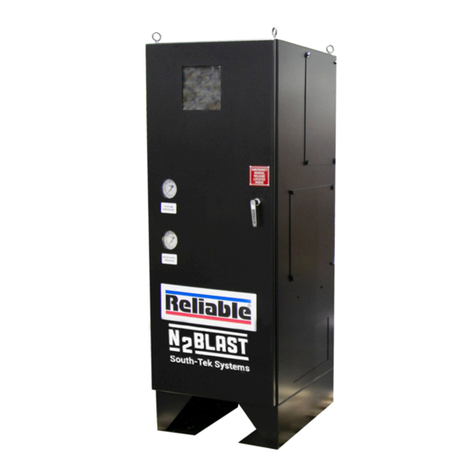
Reliable
Reliable N2-Blast DDX-LP PrePaK Maintenance manual
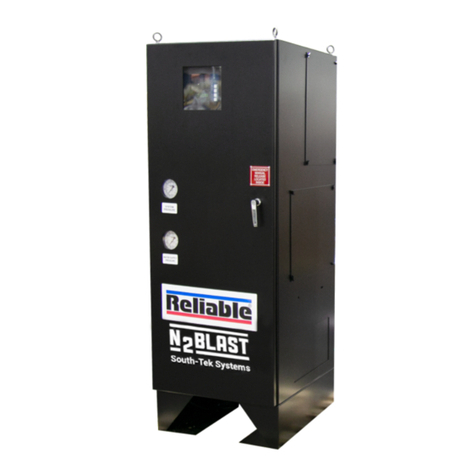
Reliable
Reliable N2-Blast DDX Maintenance manual
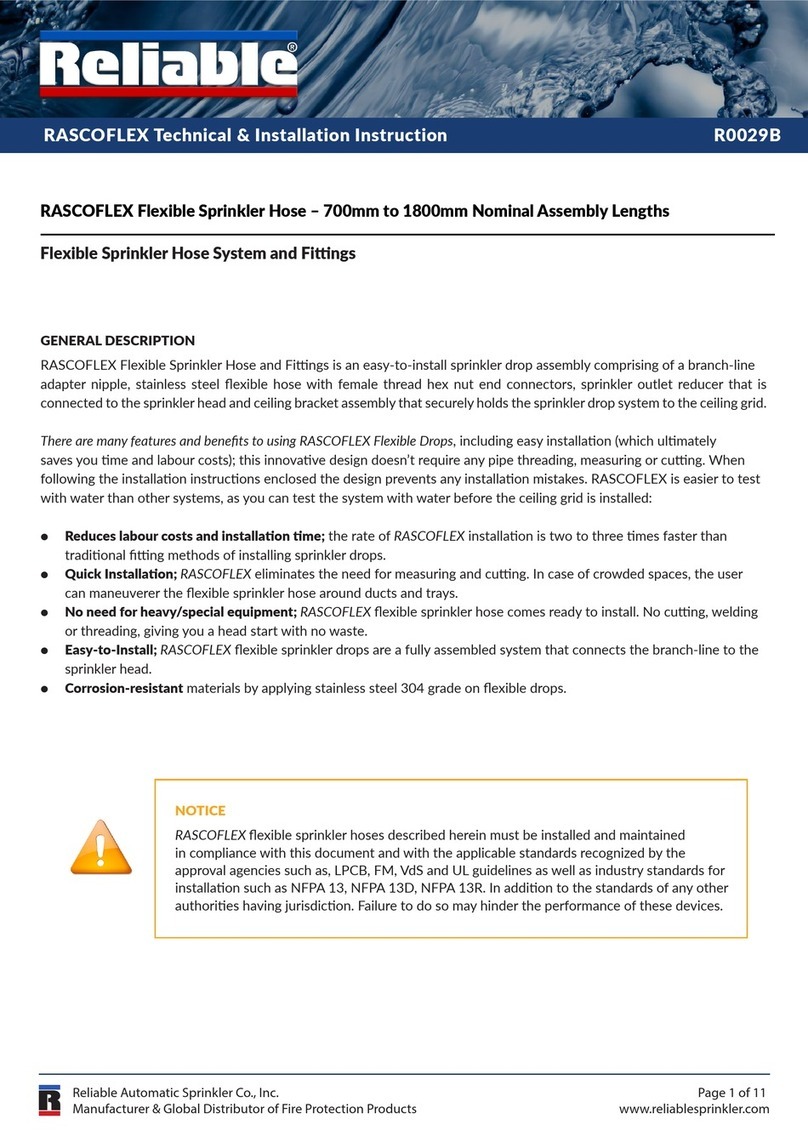
Reliable
Reliable R0029B User manual
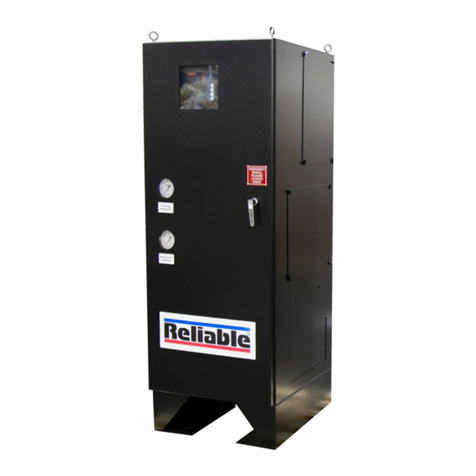
Reliable
Reliable DDX PrePaK Maintenance manual

Reliable
Reliable 500PS User manual
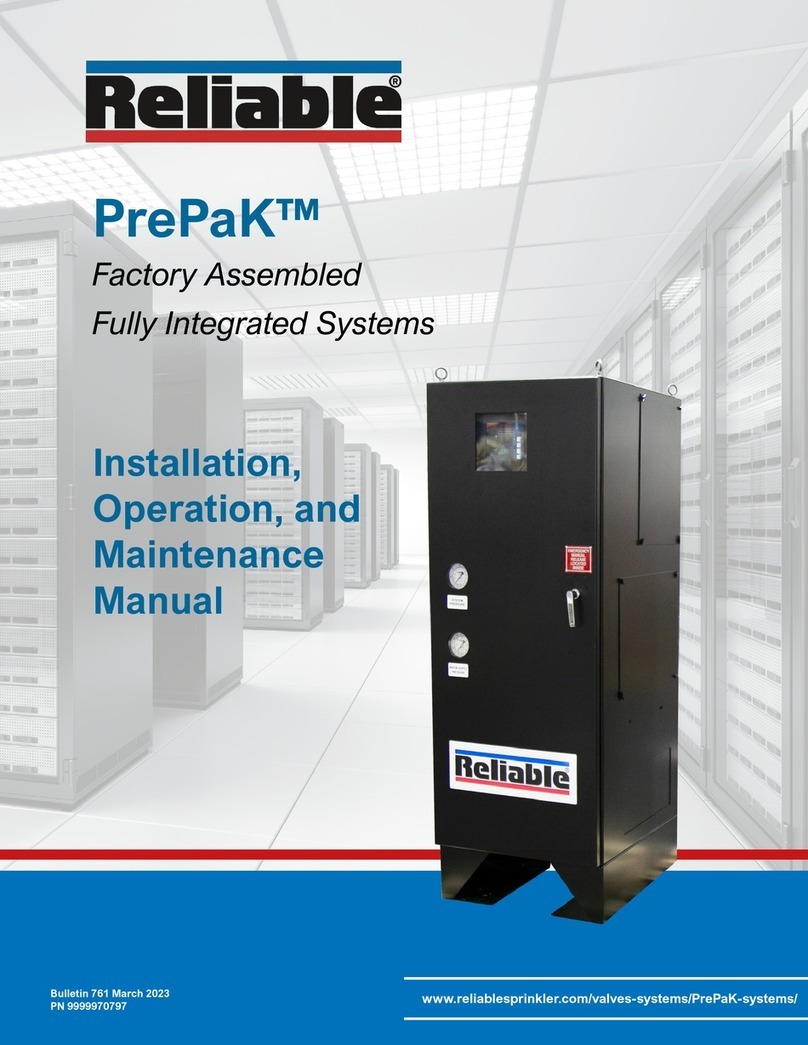
Reliable
Reliable DDX PrePaK User manual
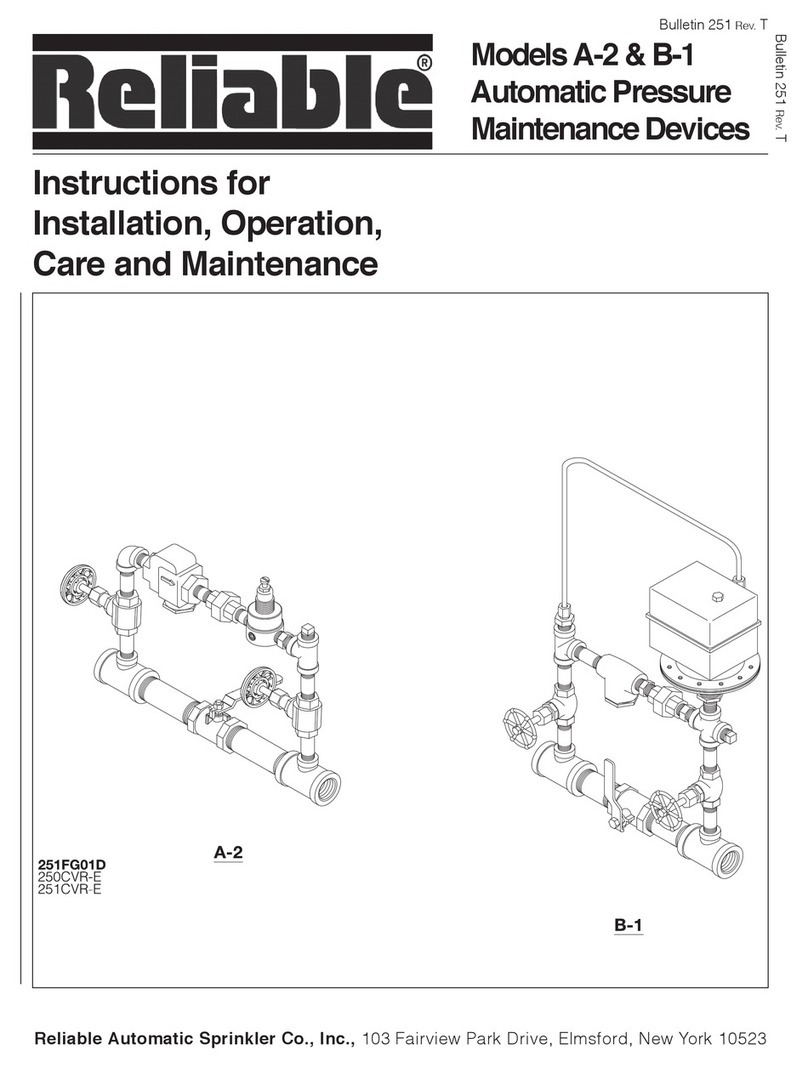
Reliable
Reliable A-2 Maintenance manual
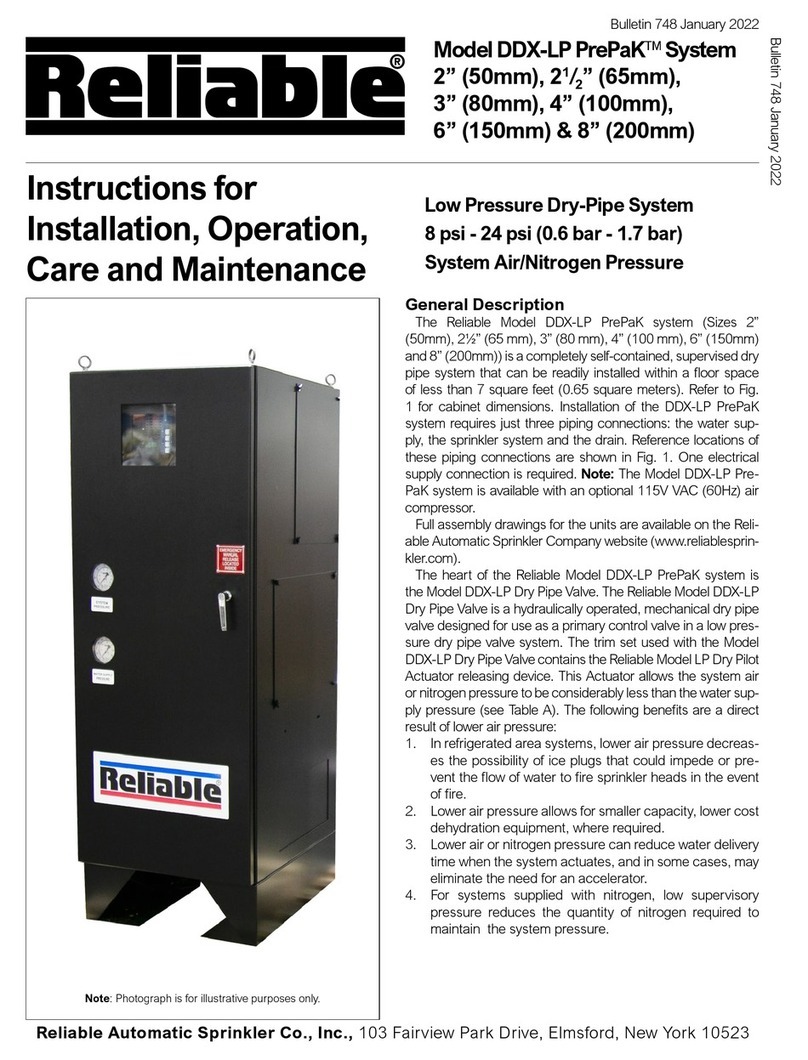
Reliable
Reliable DDX-LP PrePak Maintenance manual
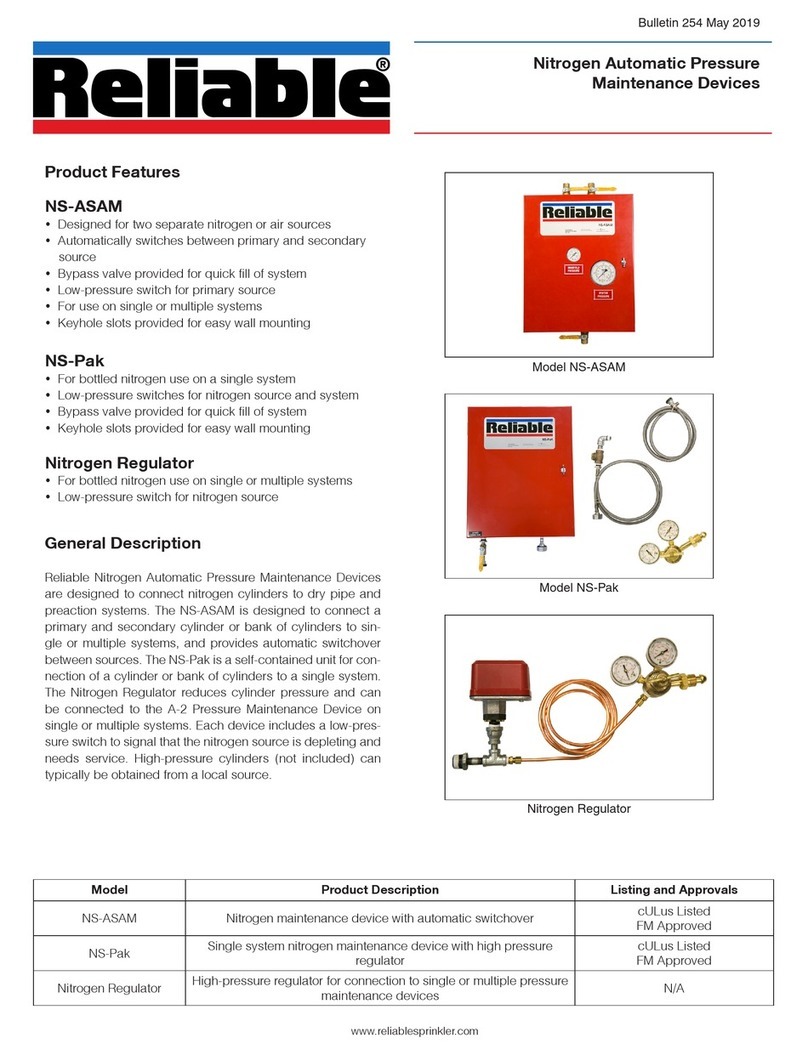
Reliable
Reliable NS-ASAM Manual
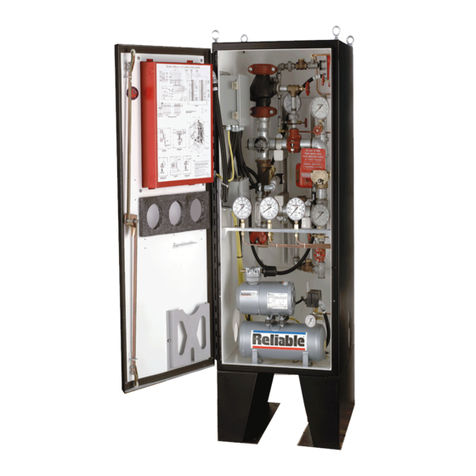
Reliable
Reliable H PrePak User guide
